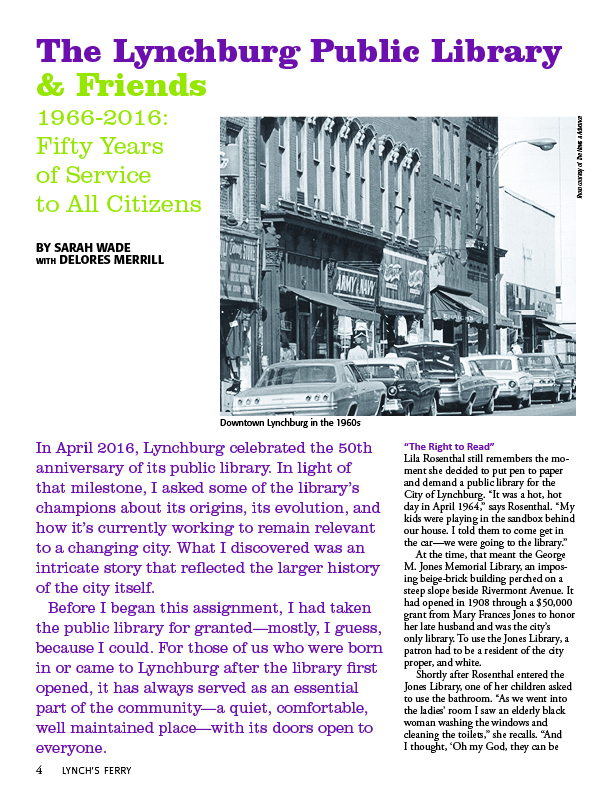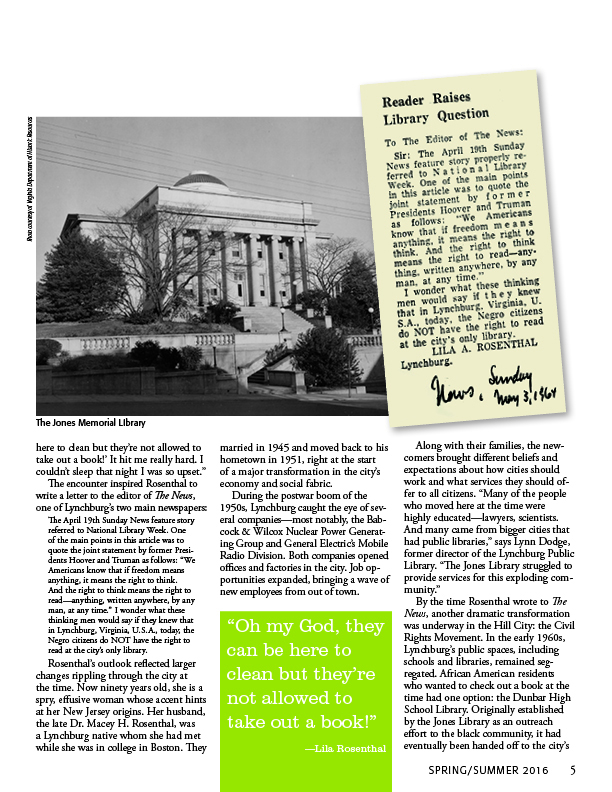The Lynchburg Public Library & Friends 1966-2016: Fifty Years of Service to All Citizens


In April 2016, Lynchburg celebrated the 50th anniversary of its public library. In light of that milestone, I asked some of the library’s champions about its origins, its evolution, and how it’s currently working to remain relevant to a changing city. What I discovered was an intricate story that reflected the larger history of the city itself.
Before I began this assignment, I had taken the public library for granted—mostly, I guess, because I could. For those of us who were born in or came to Lynchburg after the library first opened, it has always served as an essential part of the community—a quiet, comfortable, well maintained place—with its doors open to everyone.
Lila Rosenthal still remembers the moment she decided to put pen to paper and demand a public library for the City of Lynchburg. “It was a hot, hot day in April 1964,” says Rosenthal. “My kids were playing in the sandbox behind our house. I told them to come get in the car—we were going to the library.”
At the time, that meant the George M. Jones Memorial Library, an imposing beige-brick building perched on a steep slope beside Rivermont Avenue. It had opened in 1908 through a $50,000 grant from Mary Frances Jones to honor her late husband and was the city’s only library. To use the Jones Library, a patron had to be a resident of the city proper, and white.
Shortly after Rosenthal entered the Jones Library, one of her children asked to use the bathroom. “As we went into the ladies’ room I saw an elderly black woman washing the windows and cleaning the toilets,” she recalls. “And I thought, ‘Oh my God, they can be here to clean but they’re not allowed to take out a book!’ It hit me really hard. I couldn’t sleep that night I was so upset.”
Before I began this assignment, I had taken the public library for granted—mostly, I guess, because I could. For those of us who were born in or came to Lynchburg after the library first opened, it has always served as an essential part of the community—a quiet, comfortable, well maintained place—with its doors open to everyone.
Lila Rosenthal still remembers the moment she decided to put pen to paper and demand a public library for the City of Lynchburg. “It was a hot, hot day in April 1964,” says Rosenthal. “My kids were playing in the sandbox behind our house. I told them to come get in the car—we were going to the library.”
At the time, that meant the George M. Jones Memorial Library, an imposing beige-brick building perched on a steep slope beside Rivermont Avenue. It had opened in 1908 through a $50,000 grant from Mary Frances Jones to honor her late husband and was the city’s only library. To use the Jones Library, a patron had to be a resident of the city proper, and white.
Shortly after Rosenthal entered the Jones Library, one of her children asked to use the bathroom. “As we went into the ladies’ room I saw an elderly black woman washing the windows and cleaning the toilets,” she recalls. “And I thought, ‘Oh my God, they can be here to clean but they’re not allowed to take out a book!’ It hit me really hard. I couldn’t sleep that night I was so upset.”
^ Top
Previous page: From the editor
Next page: Robert C. Wesley, M.D. and the Racial Integration of Medical Care in Lynchburg
Site Map




